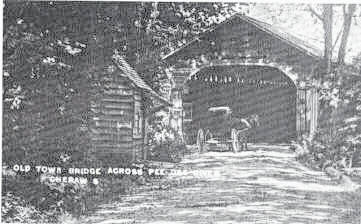At first, the many Native tribes that lived along the Pee Dee River used dugout canoes to navigate the mighty river. When the white settlers came, they also used small wooden johnboats or rafts on the river.
As the need for livestock and farm products to be moved or sold at market increased, private ferries came into use along the Pee Dee.
The first bridge to cross the mighty river was built in 1823, just south of us in Cheraw, S.C. It was a wooden, lattice-covered, privately- owned bridge that charged tolls to cross it. Some of the rules to cross the bridge were to stay to the right and don’t stop your wagon or cart in the middle of the span.
Before we discuss more about the bridge, a little history of Cheraw is needed. It began as a Native American village on a hill just above the river. In the early 1700’s, after the Native Americans left or died out, it became a small trading post. It was strategically located at the head of the inland navigation from the Atlantic Ocean.
It wasn’t long, with a thriving commerce and farming area, that Cheraw or Cheraw Hill, as it was sometimes called, became a vibrant village with homes and a few businesses. Its inland port brought in supplies from all over the world, but during the Revolutionary War, it also brought in the British Army. The war blew hard in the Cheraw area and it took several years for it to recover.
In the early 19th century, cotton became the cash crop in the south. With the invention of the cotton gin more cotton than ever was grown. Also, steamboat power took away the sailing ships and barges. They could easily make the four day and six hour trip loaded with bales of cotton going to the markets at Georgetown and Charlestown. Among the first steamboats to dock at Cheraw was the Pee Dee, whose captain was Moses Rogers. He was the captain of the Savannah during the first transatlantic steamboat crossing. Other boats operating on the river were the Maid of New Orleans, Anson, Marion, Osceola, Swan, Ghio, and the Chesterfield. Each boat could carry between 600 and 800 bales of cotton. The bales averaged about 500 pounds each. The cost to ship a bale of cotton to Georgetown on a steamer in 1824 was 75 cents, and this included insurance.
A bridge was badly needed to get wagons loaded with cotton bales and other crops across the mighty Pee Dee to the wharfs of Cheraw, which is located in Chesterfield County, South Carolina. A lot of cotton and corn was being grown across the river in the rich soils of Marlboro County, S.C. and in eastern N.C., and they all needed a way to get their cash crops to market down river.
It took about two years to build the first bridge, but even then, the river wouldn’t take too kindly to having a man-made structure in its midst. With no dam control, within two years the new bridge washed away. A new one was built and lasted till the last months of the Civil War.
During the Civil War, it was Union General Grant’s original plan that when General Sherman reached Savannah, or the first port on his march to the sea he and his army would be picked up by the Union fleet and carried to Virginia. However, the plan changed! Grant and Sherman decided that Sherman’s army would ravage the state of S.C. even more than Georgia because it was the first to secede from the union.
Most people thought Sherman would march toward Charleston, but instead he turned northwest toward Columbia, S.C. After Columbia was burnt to the ground, Sherman again threw the Confederate Army another curve by marching his army to Cheraw.
In the last year of the war, Cheraw had been turned into a depot for goods, both military and civilian. There were warehouses full of war materials, tons of ammunition and powder stored. Sherman thought it would be an easy target, and if he could secure the only bridge on the Pee Dee, it would provide a much quicker way to invade N.C.
When Sherman closed in, the Confederate Army held the town just long enough to get their fleeing army across the bridge into Marlboro County and then on into N.C. The last units of the Confederate troops burnt the bridge behind them hoping to slow down the advancing union army.
Sherman was delayed around Cheraw for three days while his engineers built a pontoon bridge across the river. Sherman said that this would be a time for his army to cool down before entering one of the last states to secede.
Although Cheraw was spared, it was during these three days that the rural parts of Chesterfield County and surrounding areas suffered under Sherman’s bummers and so-called foragers. What they didn’t outright steal, they burnt, and were not above killing folks.
After the war, the bridge was rebuilt and remained until a great flood came in August, 1908. Most of the bridge came down, but a portion on the Cheraw side was salvageable. A metal span was added to rebuild the bridge. In 1938, a new bridge was built just above the old one. It spanned the new Jefferson Davis Highway that we refer to today as Highway 1.
Seems since the early days, man has tried his best to harness the power of the river. They have built dams and bridges, but there are still times when the river shows us that nature is still in control.
J.A. Bolton is author of “Just Passing Time,” co-author of “Just Passing Time Together,” and recently released a new book “Southern Fried: Down-Home Stories.” Contact him at [email protected].


